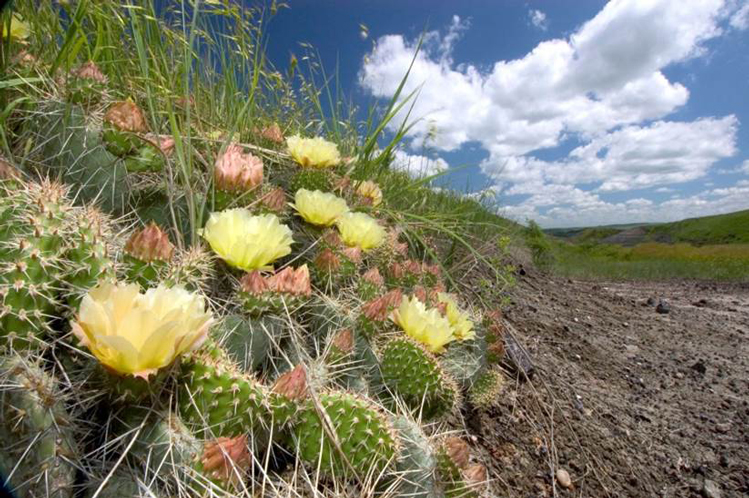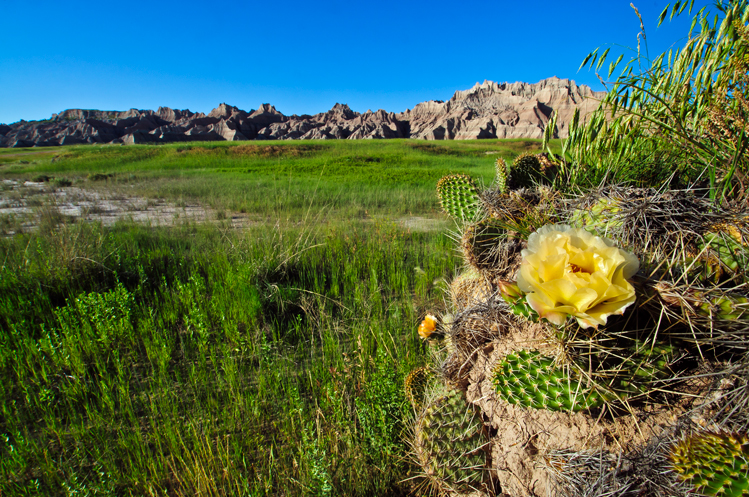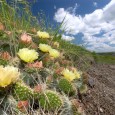The Gift of South Dakota
Subscriptions to South Dakota Magazine make great gifts!
Subscribe today — 1 year (6 issues) is just $29!
The Joys of Cactus
 |
| Six species of cactus, including these prickly pears, can be found in South Dakota. Photo by Chad Coppess/S.D. Tourism |
One time I walked barefoot through this West River prairie. I'd just waded across the Grand River in an area of Forest Service land north of Bison, headed for some high sand dunes along the river. The fine gray sand of a cow path enticed me, and I kept my boots off.
It was unnerving. My brain knew nothing could grow in that trail, but my feet half expected a painful poke from a cactus spine. Perhaps some dried-up chunk of prickly pear, its spines still sharp and hard, had been carried there on a cow's hoof. My feet knew firsthand about jumping cactus.
If you're not familiar with jumping cactus, a kind of prickly pear, don't worry. One will find you. You'll be striding along and suddenly feel a nerve-jangling stab in one knee. Look down and there's a cactus impaled there. It's a small stem, barely an inch long with spines even longer, that broke off from the main plant when touched by your boot. From there it travelled up your pant legs from one to the other, until it reached your knocking knees.
When you toss the thing aside in disgust, that's just fine with the cactus — it may root down there and start a new life. Where there was one plant are now two, and you've served the jumping cactus' survival, reproducing by division.
The jumping cactus is also known as brittle cactus, and probably has been called other cursed names. It's one of six species of cactus that call South Dakota home. The most common are the prickly pears, which grow with jointed segments shaped like mice ears. The other species are rather small, rounded balls or columns. There are two kinds of the aptly named pincushion cactus — if you can imagine a pincushion with the points sticking out. The rarest one is the hedgehog cactus, which ranges into the southwest corner of the state and is unique for having green flowers.
Cacti are plants that have evolved strictly in the Americas, and are related to rough and succulent plants like purslane and pigweed. Another classification for our region could rank them between needle grass and rattlesnakes, along with yucca, catfish, wasps and porcupines: the armed and dangerous class.
In South Dakota, only the brittle cactus and one of the pincushion species can be found east of the James River. They all can live most anywhere, from hard rock cliffs in the Black Hills to cut banks along the Missouri River, and in the many varieties of clay in between. Even low places have cactus, especially West River, where such places don't stay wet for long.
Although they are living symbols of deserts, cacti are actually all about water. They excel in living without rain, sopping it up when it comes, and then storing it for long periods. They have only tiny leaves that soon fall; it's the stems that carry on photosynthesis for the plant. The stems have a thick, waxy skin with only a few pores to transpire moisture. The pores open mostly in the cool of the night.
Between rains, the stems shrivel and the roots contract to save moisture. A broken off piece of stem can be quite dry and still be revived by precipitation. When rain does come, the cactus' shallow roots send out fast growing rain roots to gobble it up. Few other plants are so adapted for exploiting the ephemeral moisture of light showers. The rain is promptly transported to stems, which swell for storage.
Cactus in our region also must survive winter. Most species of cactus are restricted to regions with mild winters. Here, they shrivel before winter — with less water, they're less apt to burst from freezing. They also go though a process called cold hardening, which gradually prepares them for sub-zero temperatures. One cactus researcher found that pincushion cactus have the greatest ability among the 20 species studied to cold harden. That cactus has a range that reaches into southern Canada.
 |
| Cacti can grow everywhere from river valleys to the Badlands. Photo by Chad Coppess/S.D. Tourism |
The spines are the final touch. Without them, such succulent plants wouldn't last 10 minutes out here. Prickly pears have an added detraction: fine, pointed hairs that surround the spines. Called glochids, these barbed bristles are painful all out of proportion to their size. With their size and golden translucence, it's an added pain just to find and remove them from your skin.
So, are cacti good for nothing? Animals can graze the plants — after a wildfire has singed off the spines. In hard times, ranchers in the southern plains have used torches for that purpose, to provide livestock forage.
Prairie birds such as upland sandpipers and lark sparrows have been observed to nest in patches of prickly pears. In that thorny fortress the birds can rest assured a soft-pawed predator won't just stumble upon their nest. The patches are often riddled with burrows of small rodents, as well.
The cacti also serve as a refuge for other vegetation. Livestock and other animals won't graze too close to the spines, so grass and other prairie plants can thrive there, especially in droughts when grazing can have great impact. As the drought ends, the grasses recolonize the grazed areas, and the cacti go into a relative decline.
For people, cacti have long been a source of food. There's evidence that Plains people were eating the prickly pear pads and fruit as early as 6,000 years ago. The fruits, called pears, are especially sweet. They ripen to a magenta red in July and are eaten fresh, or dried for later use. In modern times, the pears are used for making jellies and candy.
The pincushion cactus also has edible fruit. The fruit ripens in April, a year after flowering. Although the plants are low to the ground with fruits barely a quarter inch long, the fruits stand out in that season, when they are by far the reddest thing around. I use a little plant stem to pop them loose from the protective spines, then spit out the tiny seeds as I savor the sweet pulp. I like to think they're capsules of vitamin A, and that eating them helps me see them.
Dakota Indians have often eaten the pads of prickly pears raw, or dried them for use in thickening soups. The inside of the pads contains a slippery, sticky mucilage, which is good for fixing paint on hides. That mucilage makes the opened pads a soothing dressing for wounds, much like aloe vera.
Settlers along the Missouri River found yet another service for the pads. They cut them open and placed them in a bucket of muddy river water. The mucilage soaked up the sill, clearing the water for drinking.
For those who find the very thought of eating cactus painful to contemplate, spineless varieties are available. Called nopales, they are commonly used in Mexican cooking, and can sometimes be found in larger supermarkets.
One thing everyone can agree on — the flowers are gorgeous. Borne atop the plants as if focused on the sun, the blossoms are showy with a texture reminiscent of silk flowers. The colors range from brilliant yellow to deep pink.
It's the flowers, as well as the hardy and exotic growth of the stems, that make cactus plants so attractive to gardeners both indoors and out. One South Dakotan who made a career of his passion for cactus and other prairie plants was Claude Barr. Barr homesteaded in the Smithwick area of Fall River County in the early 1900s. His family survived on the limey upland soils there partly because he made an income from selling seeds and plants to gardeners around the world.
In his long life, Barr traveled widely over the Great Plains, and transplanted many of his favorite wildflowers to the yard of his "Prairie Gem" ranch. He ultimately shared much of his experience, knowledge and love for native plants through a book, Jewels of the Plains.
Through Barr's writing, the plains come to light as a living fabric of plants. It's a fabric of great breadth and incredible detail, ever-changing and almost animated. For instance, Barr calls the jumping cactus "the little hitchhiker," and speaks of it enlarging its territory in North America by riding in the hides of animals.
Barr brought several new varieties of plants to the attention of the horticultural world, including prickly pears known for their spectacular flowers and colored spines. A badlands milkvetch that he first identified bears his name.
Continuing the work of Claude Barr is one of the missions of the Great Plains Native Plant Society, based in Hot Springs. One of the Society's prime goals is to create botanic gardens for Great Plains plants.
Cindy Reed, president of the Society, reports that they are on the verge of choosing a site near the Black Hills. Once established, the garden will be the first of its kind to feature plants of a very large yet somewhat overlooked region, the Great Plains.
The botanic gardens might not feature the jumping cactus; it's just too much of a nuisance. But as an educational tool, it could save people from learning some painful lessons.
The tale is told of a South Dakota rancher who stepped outside in stocking feet and was greeted by a prickly pear that had rooted in his lawn. He went after it with an axe. That prickly pear had revenge of its own, though. By the next spring all those hacked-up pieces had sprouted roots and made new plants.
Back in the 1960s, another rancher, living on some really poor soil east of Newell, tried a novel solution for the prickly pears that covered his pasture. He used a swather and ran it low over the ground through the cactus. It worked.
Those prickly pears were all gathered into swaths. Of course, they rooted down, becoming a rabbit-high shelterbelt of cactus. They're probably still there.
Hard experience has shown those cacti are tough to beat. Trouble is, you can't quite join 'em either.
Editor’s Note: This story is revised from the July/August 1997 issue of South Dakota Magazine. To order a copy or to subscribe, call (800) 456-5117.





Comments